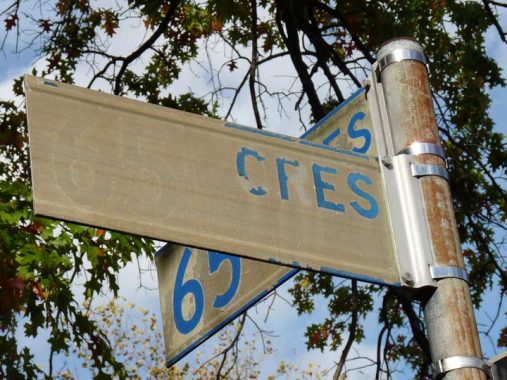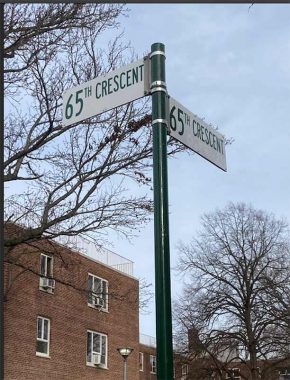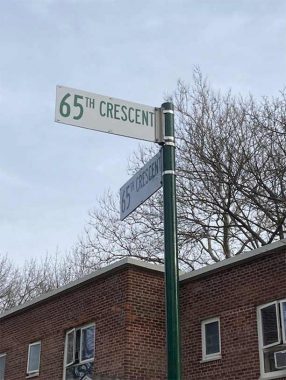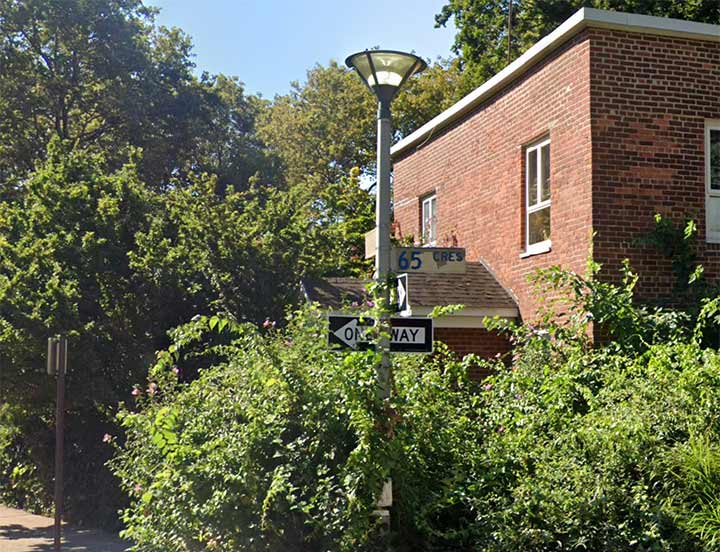
THE central Queens neighborhood Fresh Meadows, known best for the eponymously-named extensive residential community centered at 188th Street and the Long Island Expressway that was constructed there between 1946 and 1949 by the New York Life Insurance company. Prior to the apartment complex, the area’s claim to fame was Fresh Meadows County Club and golf course that hosted the U.S. Open in 1932. The housing mix is 3-story apartment buildings in garden settings, with a couple of high-rise towers.
Fresh Meadows History has some vintage photos from the 1940s and 50s.
Fresh Meadows takes its name from its contrast to neighboring Flushing, whose name is a transliteration of the Dutch “Vlissingen” meaning “salt meadow valley.” Ponds and creeks running through the neighboring area to the southeast were likely “fresher” or free of salt, and so Fresh Meadows replaced the harsher-sounding older name for the region, Black Stump, which apparently referred to burned, blackened stumps that marked the edges of farms. Until about 2000, one of Queens’ last remaining farms, belonging to the Klein family, sold produce on a roadside stand at 73rd Avenue and 199th Street.
From the beginning Fresh Meadows, which is a semiprivate development has had its own set of streetlamps, cylindrical poles that in the 1940s and 50s supported incandescent lights. They have recently been fitted with “Conehead” Light-Emitting Diode luminaires, which shine piercingly white.
Of course, you’ll also note something else. 65th Crescent in Fresh Meadows has the last remaining set of 1960s vintage White street signs with blue type that were installed by the thousands in Queens.There is a pair on this lamp…

…and another pair mounted across the street on an iron pole. However, a change has recently been made.


… a new pole and a new pair of signs have been installed to replace the vintage signs. Apparently these were commissioned by the housing development, as the Department of Transportation would have installed regulation green and white. An anonymous Forgotten Fan supplied the images.
I am of two minds. The vintage signs were mostly illegible; however, their loss leaves just the pair attached to the lamppost as the last remaining of Queens’ vintage white and blues.
As always, “comment…as you see fit.” I earn a small payment when you click on any ad on the site.
1/9/23


15 comments
I did not know that some of those vintage signs were still there until recently.. Fascinating, thanks.
Incidentally, it was the Fresh Meadow Country Club that NY Life bought the property from (and NY Life called the new housing complex Fresh Meadows).
I lived on 198th Street between 73rd and 75th Avenues from 1950 until 1970, and I never saw a produce stand at 73rd Avenue and 199th Street. The farm was between 194th and 195th Street.
Close.
Actually, the Klein farm produce stand on 73rd Avenue was much closer to 188th St & it operated seasonally before its closure in 2000.
Fresh Meadow Country Club is still exant, however they are now located in near by Lake Sucess. Two other former northeastern Queens clubs relocated across the county line; North Hills Country Club to North Hills and Deepdale Country Club to North Hills as well. Deepdale left its mark as the Deepdale Gardens Cooperative Apartments and North Hills as the North Hills Branch of the Queens Library.
Indeed…the farm was not on 199th.. I have returned to live in my childhood home on 197th st between 73rd and
75th ave and the farm was definitely as Ira states…quite a shame whats
happened to the farm. Wish we
couldve had it deemed a landmark.
That’s correct Ira.
Fresh Meadows is also unique in that parts of its border consist of two different abandoned transportation rights-of-way. Peck Avenue ran alongside the Central Railroad of Long Island, which was created by A.T. Stewart to bring passengers and freight to his new community Garden City. It operated from about 1870 to 1879, when the line was abandoned from Flushing to the site of Creedmore Psychiatric Hospital. It became the strip of park that runs From Flushing Meadow to Cunningham Park.
The other right-of-way was the Vanderbilt Motor Parkway, which began on Nassau Boulevard (today’s Horace Harding Boulevard) adjacent to what is now 199th Street. William K. Vanderbilt extended his parkway to Fresh Meadows in 1911. The Parkway went bankrupt and the roadway was abandoned. In Queens it became part of the NYC Parks Department. Today, it remains as a bicycle path, using the original Parkway overpasses, that runs from Cunningham Park to Alley Pond Park.
“Back o’ the Black Stump” is also an Australian expression that roughly connotes “beyond the last civilized place before you’re REALLY in The Outback”– it derives from the same meaning you’ve ascribed to it, i.e., boundary markers.
My suspicion is that the settlers in that area and the settlers in Australia, in the use of that name, were both alluding to some sort of English custom for setting the metes and bounds of their property.
Is that corner of 65th Crescent and 65th Crescent?
I moved to 198th St & 73rd Ave in 1947, watched Fresh Meadows & Meadow Lark Garden Apts built. As my brother Ira noted, the produce stand was only in front of the Rottkamp farmhouse which was next to the PS26Q playground by the basketball courts.
I grew up in Fresh Meadows and enjoyed your discussion of its history. Thank you. We used to buy produce at the Klein Farm, when we lived at 71st Crescent quite close by. I wonder how many of the landscape features of the development were a legacy of its former existence as a golf course.
Vlissengen, a port city has been a city in the Netherlands since 1315. The English always called Vlissengen Flushing. Before New York was an
English colony it was a Dutch enterprise.. In 1639 Governor William Kieft bought the land that became Queens County, and on October 10, 1645 the land that became Flushing was officially founded and named Vlissengen, after a Dutch village. The name was changed to Flushing after British takeover.
Hey is the anonymous guy Scott Arnoff????
Those street signs reminded me of the time when each of nyc’s five boroughs had their respective colors of street signs. That came in handy as far as the Brooklyn/Queens border that very often meanders. Obviously, some city planner had probably never heard of the old adage, “IF it ain’t broke don’t fix it”.